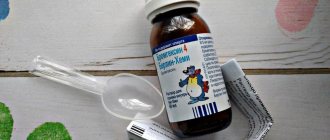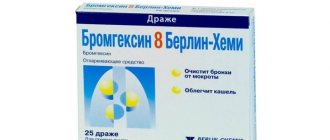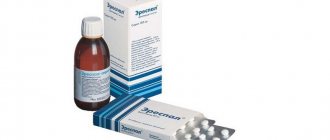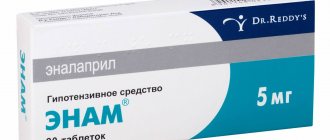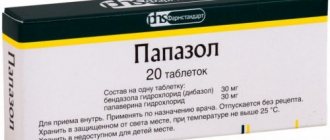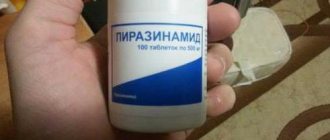There are a huge number of medications used to get rid of cough, one of them is Bromhexine.
Proper use of medications allows you to endure a disease, the main symptom of which is cough, with minimal stress on the body. Therefore, it is very important to know which cough Bromhexine should be taken for.
Among seasonal diseases, the most common are acute respiratory viral infections and acute respiratory infections; they occupy a leading position in the number of relapses annually. All these diseases are caused by viral bacteria that affect the lower or upper respiratory tract.
Due to irritation of the respiratory system, the body sends certain signals to the brain, and a cough occurs reflexively. But this symptom also occurs for another reason. The thing is that after damage to the lower respiratory tract, additional mucus is formed in the bronchi. Then the sputum containing the virus is separated. And here, the main thing is to quickly and effectively remove it from the body. This process occurs during a cough.
It should be remembered that there are several types of cough. For example, if it occurs after throat irritation, then it is dry. Well, when an excessive amount of fluid has accumulated in the organs of the respiratory system, then we are talking about wet.
The second type helps get rid of viruses, cleanse the body and speed up recovery in general. But the first one essentially only depletes the body. It is necessary to help the body increase the volume of sputum production, as well as make this process easy and painless for the patient. And, of course, relieve the inflammation itself.
What is it used for?
The drug is an expectorant and is prescribed for the treatment of cough in children and adults. Efficiency is due to the ability of the components included in the tablets or syrup to dilute mucus and promote its removal.
Bromhexine stimulates the secretory cells of the bronchial mucosa, where sputum is produced.
Indications:
- bronchial asthma;
- tracheobronchitis;
- Chronical bronchitis;
- pneumonia.
All diseases are characterized by the formation of thick, difficult-to-dispose secretions.
Composition and release form
The drug is available in different forms. Available as tablets or elixir. The form of tablets for children is 4 mg, 10 pieces per package; for adults, Bromhexine Berlin tablets for cough are in a dosage of 8 mg. Bromhexine syrup is sold in 100 ml containers. Children's syrup is produced in dosages of 60 and 100 ml. The main substance in the composition is hydrochloride.
Bromhexine syrup
What is better, Bromhexine syrup or tablets?
As already mentioned, the medicine is sold in the form of tablets or cough syrup. Cough tablets contain sugar as an auxiliary element. These types of drugs are contraindicated for people with diabetes. Cough syrup contains sorbitol, which is a sweetener. Therefore, for diseases associated with endocrine system disorders, it is better to take syrup.
Also, the medicine in the form of an elixir is better for children and people with swallowing disorders. It is more convenient for adults to take the substance in tablets and wash them down with water than to constantly dose liquid syrup.
When buying syrup, you should pay attention to the composition; it should contain no alcohol. Otherwise, it cannot be taken by children and people with liver problems.
Contraindications
The use of the drug in the following situations is strictly prohibited:
- Lactation period in women.
- The period of exacerbation of peptic ulcer of the gastrointestinal tract.
- First trimester of pregnancy.
- Children's age: up to 2 years for syrup and 6 years for tablets.
- Intolerance to the components of the drug.
- Hypersensitivity to sugars.
When consulting with a doctor, be sure to notify about the presence of illnesses or pregnancy. This way the doctor can prescribe safe and effective treatment.
Bromhexine for children and reviews
Bromhexine is actively used and recommended for use in childhood, as the drug has shown itself to be effective in the fight against cough. However, it is not equally good for wet and dry coughs.
The main advantages of using the drug for children are the convenient dosage of both forms, the pleasant taste and aroma of the medicine. In addition to ease of use, a separate column among all the advantages highlights the complex effect on the body. Indeed, in addition to mucoregulatory, mucolytic and expectorant properties, the drug also has antitussive abilities.
For wet coughs, it is used to quickly remove sputum. In addition to the external effect on sputum, the medicine also works from the inside, producing neutral mucopolysaccharides that facilitate expectoration. Thanks to this effect, the child’s dry cough is moistened and the wet one is normalized.
It is used for complications of diseases in children. These are mainly measles, rubella, scarlet fever, mumps and chicken pox. Additionally, it has shown positive results when used with nasopharyngitis, laryngitis, tracheitis or bronchitis.
On a note! The drug is quite effective, has no serious contraindications, is quite safe and convenient - all this makes it very popular.
Of course, there are analogues of this medicine. But in any case, before starting the treatment process, you should definitely consult a doctor and clarify all the nuances.
When to take with caution
The drug should be prescribed by the attending physician, taking into account the characteristics of the patient. These include:
- liver or kidney diseases, gastrointestinal tract;
- diabetes mellitus type 1 or 2;
- periodic internal bleeding in the intestines or stomach;
- diseases of the respiratory system with the accumulation of large amounts of sputum
The use of the drug in the second and third trimester of pregnancy should be under the supervision of the attending physician. If there is a need to use the medicine during breastfeeding, it is necessary to weigh the benefits and possible risks. The components in the product can pass into breast milk and enter the baby’s body with it.
Indications for use of the medicinal product
You need to understand for what disease you need to use Bromhexine tablets; here it is important to know not only what cough to use it for, but also specifically for what disease. Of course, the prescription must be made by the attending physician, who will prescribe the medicine and indicate the method of its use. But in general, the drug is recommended for diseases such as:
- Tracheitis and laryngitis.
- Acute forms of pharyngitis.
- Bronchial asthma, if it is accompanied by the production of viscous or poorly separated sputum.
- Pulmonary emphysema.
- Severe forms of bronchitis and tracheobronchitis. Sometimes used for obstructive bronchitis.
- Infectious diseases of the upper and lower respiratory tract. Also used for complicated forms.
- Chronic laryngotracheitis and nasopharyngitis.
- Tuberculosis.
- Pneumoconiosis.
- Congenital pathologies of the bronchi or lungs.
For some diseases, Bromhexine is used as the main treatment. And, it should be noted that it helps solve the problem very effectively.
If we talk about what kind of cough to take Bromhexine tablets for, then it should be noted that it is effective for any type of cough. The drug is taken only under the supervision of a doctor, who will also give recommendations on dosage.
On a note! Quite often, Bromhexine is prescribed to children, since it does not contain alcohol.
Thanks to this property, it interacts better with other drugs. Doctors prescribe the medicine even for children under three years of age, as it is completely safe.
What side effects may there be
Unpleasant consequences of using Bromhexine can be caused by an overdose or the patient’s individual intolerance to the components of the drug. These are:
- indigestion;
- nausea and vomiting;
- dizziness;
- headache;
- rash on the body, redness of the cheeks, nasal congestion, Quincke's edema;
- increased activity of liver derivatives.
Basically, the medicine is easily tolerated and does not cause any discomfort.
Impact on the body
Its work consists of a secretolytic and mucolytic effect on the diseased organ. It is able to be quickly absorbed into the gastrointestinal tract and then enter the blood, which transfers the medicine to the secretory cell of the respiratory organs. And then from it it enters the sputum and breaks down its large-formed complexes into smaller compounds. As a result, it becomes less viscous and can flow freely and come out when coughing. Due to this, the work of the ciliated epithelium is normalized, and it removes phlegm faster. Therefore, the cough goes from dry to wet.
How to use
Depending on the age and weight of the patient, the drug is prescribed based on the number of milligrams per kilogram of weight.
Children under 2 years of age are not recommended to use Bromhexine; syrup is used in pediatrics for ages 2 to 6 years, tablets for children over 6 years of age and adults.
Adults are prescribed 1-2 tablets (8-16 mg), 3-4 times a day.
At the age of 6 to 14 years, the daily dose of 8 mg of the drug is divided into 3 doses.
The active substance content in the syrup is 4 mg per 5 ml of syrup. Appointed
depending on the age and weight of the child from 2 to 8 mg:
- from 2 to 6 years 2.5-5 ml of syrup, i.e. 2-4 mg 3 times a day;
- at the age of 6-10 years it is necessary to take 5-10 ml of syrup (4-8 mg) three times a day;
- over 10 years old, 10 ml every 6-8 hours.
When choosing a dosage, it is necessary not only to focus on the child’s age, but also on his physical condition. If a 2-year-old child is ahead of his peers in height and weight, you can safely increase the dosage, since the dosage indicated in the instructions will be ineffective. The same applies if the child is smaller than his peers. In this case, you need to slightly reduce the amount of ml of medicine.
Bromhexine tablets
Cough, which is a protective reflex reaction of the respiratory system, occurs in many infectious diseases (laryngitis, bronchitis, pneumonia, etc.).
As a rule, at the beginning of the disease there is a dry paroxysmal cough, which soon turns into a wet cough with difficult to separate sputum. In this case, it is advisable to take medications that help the body quickly remove phlegm - mucus, which contains pathogenic microorganisms. Bromhexine cough tablets are widely used, the features of which we will discuss in this article. Bromhexine - composition and indications for use
Bromhexine is a drug whose main active ingredient is bromhexine hydrochloride. The auxiliary components in the tablet form of the drug are often sugar, potato starch, calcium stearate and some other substances. It is worth noting that the tablet dosage form is convenient to use and provides high dosing accuracy.
Bromhexine is prescribed for the following diseases:
- tracheobronchitis;
- obstructive bronchitis;
- emphysema;
- bronchial asthma;
- pneumonia;
- pneumoconiosis;
- pulmonary tuberculosis, etc.
This drug can also be used to sanitize the respiratory tract in the pre- and postoperative period, to prevent the accumulation of mucus after chest injuries.
Medicinal effect of bromhexine
Bromhexine has a mucolytic and expectorant effect. The active substance is quickly absorbed from the gastrointestinal tract and distributed in the tissues of the body. Penetrating into the respiratory tract, it changes the structure of sputum, promoting its dilution and a slight increase in volume. Thanks to this, mucus is removed from the body more efficiently and quickly.
In addition, it is believed that bromhexine stimulates the production of pulmonary surfactant, a substance that lines the pulmonary alveoli and performs protective functions. The release of this substance may be impaired due to disease, but it is essential for normal lung function.
How to take (drink) bromhexine tablets?
The active ingredient in one tablet of bromhexine can be contained in an amount of 4 or 8 mg. This should be taken into account when observing the dosage of bromhexine tablets.
The drug is taken orally with water, regardless of food intake, in the following dosage:
- adults – 16 mg (2 tablets of 8 mg) 3 – 4 times a day;
- children from 3 to 4 years old – 2 mg (half a 4 mg tablet) three times a day;
- children from 5 to 12 years old - 4 mg three times a day.
The therapeutic effect appears on days 2–5 of treatment. The course of treatment ranges from 4 to 28 days.
Safety measures and recommendations when using bromhexine:
- During treatment, it is necessary to take more fluid, which increases the expectorant effect of the drug.
- Bromhexine can be prescribed simultaneously with other drugs for the treatment of bronchopulmonary diseases, including antibiotics.
- The drug should not be prescribed in conjunction with the use of drugs that suppress the cough center (for example, codeine), as this will make it difficult to remove sputum.
- Bromhexine is incompatible with alkaline solutions.
- Because Bromhexine can increase bronchospasm; it is not recommended to be prescribed during the acute period of bronchial asthma.
- For gastric ulcers, bromhexine should be taken under the supervision of a physician.
- For patients with renal failure, lower doses or an increase in the interval between doses of the drug are recommended.
- Contraindications to taking bromhexine are: first trimester of pregnancy, breastfeeding, hypersensitivity to the components of the drug.
special instructions
While taking Bromhexine, you must take plenty of fluids. This will improve the expectorant properties of the active ingredients.
To facilitate the discharge of secretions, it is recommended to do a vibration massage. To do this, you need to lay the child slightly upside down and use tapping movements to move from the shoulder blades to the head.
The medicine is prescribed in complex therapy together with herbal preparations containing essential oils (menthol, peppermint, eucalyptus oil).
Typically, the effect of using the drug becomes noticeable on the 4-5th day of treatment.
Expiration date and how to store
The drug can be used for 2 years from the date of manufacture.
Bromhexine should be stored at a temperature not exceeding +25°C, hidden from direct sunlight and kept away from children.
When is Bromhexine contraindicated?
In case of renal failure, the drug should be used with caution
In most cases, treatment with this drug is easily tolerated by patients. It is used in complex therapy; it does not enhance or reduce the effectiveness of antibiotics, painkillers or anti-inflammatory drugs. Gets along well with vitamin and heart medications. But you should refrain from taking it if allergic reactions to any of the components of the drug occur.
It should be taken with extreme caution if you have renal or hepatic impairment. For such patients, concurrent use of maintenance medications is recommended. Do not take the medication if you have a stomach or duodenal ulcer or if your stomach is not functioning properly.
It is not recommended to take the drug in the first three months of pregnancy and while breastfeeding.
Video
This video explains what kind of cough Bromhexine is used for.
The use of this drug should be carried out as prescribed by a doctor and under his supervision. Bromhexine works well in combination with other medications and enhances the removal of sputum. For what cough is it taken? They often treat dry coughs in the transition stage to wet ones. Its effectiveness is visible already on the second day. It is safe for small children if they are not allergic to the components of the drug. You just need to remember that it should not be taken together with other antitussive medications, so that they do not impede the removal of sputum.
Rengalin cough tablets are also a good analogue. Before use, be sure to consult your doctor and read the instructions. Find a list of cough syrups for children.
The drug "Bromhexine" has long become synonymous with a cough remedy, but for most people this characteristic is rather vague. The product is truly effective, but only when used correctly. What type of cough requires Bromhexine, what should it not be combined with, and how to understand all the release forms and concentrations of this medication?
In order to accurately understand whether a certain drug will help, and what medicine to go to the pharmacy for, you need to clearly define the type of cough that you need to fight against. Doctors divide it into only 2 groups: dry and wet. How are they characterized?
- A wet cough is the presence of sputum and mucus that can be easily spat out after each attack. Depending on the degree of the disease, it can be either transparent-watery or thick, and also contain bloody inclusions. Often it signals a viral infection, as well as the last stages of pneumonia, bronchitis, tuberculosis, etc.
- A dry cough is a hacking cough, without any discharge, it is usually more frequent than a wet one, and causes more inconvenience due to the quickly occurring painful sensation in the throat. Needs to soften the mucous membrane and activate sputum secretion.
It is also impossible not to note the division of cough according to clinical signs:
- A prolonged one can last from several weeks to 3 months, signaling an intensification of the disease; the attacks themselves occur infrequently.
- Chronic begins in the 4th month of protracted, becomes even more rare, but often it is deep chest, with rare sputum.
- Acute cough is characteristic of infections and respiratory diseases in the initial stages, lasts 2-3 weeks, causes a lot of inconvenience, since it is almost non-stop. Needs suppression, but expectorants should not be taken.
Side effects
Bromhexine tablets do not have a pronounced toxic effect, but despite this, the drug has a number of side effects. They manifest themselves in the form of the following atypical reactions of the body:
- Disorders of the gastrointestinal tract. Irritation of the gastric mucosa by the active components of Bromhexine tablets can lead to the patient experiencing nausea, abdominal pain, heaviness in the right hypochondrium, and lack of appetite. The development of diarrhea and vomiting with dehydration cannot be ruled out.
- Dizziness. Bromhexine has virtually no effect on blood circulation, but patients with weak cerebral vessels may experience mild pain in the temples and the back of the head. In such cases, it is recommended to stop taking the pills and take a painkiller. It is also necessary to measure blood pressure. If it is elevated, then you need to immediately call an ambulance to stabilize your health condition.
- Allergy. Patients prone to allergic reactions may experience itchy skin, a red rash on various parts of the body (most often rashes form on the abdomen), urticaria, bronchial spasm, or swelling of the nasopharyngeal mucosa.
This is an exhaustive list of possible side effects that have been documented in multiple clinical trials. Also, do not discount the individuality factor of each patient’s body. Other indirect manifestations of non-perception of the drug cannot be excluded. Therefore, in the process of treating pulmonary diseases accompanied by a strong dry cough with Bromhexine tablets, you need to listen to the behavior of your body.
How does the drug "Bromhexine" work?
To understand which cough Bromhexine helps best with, you need to look at the principle of its operation. What components does this drug use and what properties does it have?
- The action of the active components (in particular, acidic polysaccharides) of Bromhexine is aimed at stimulating the glands of the mucous membrane, which leads to an increase in sputum secretion and a decrease in its viscosity. Strictly speaking, the drug does not help with cough - on the contrary, it strengthens it, but at the same time makes it more productive, since part of the mucous secretion is separated and removed from the bronchi and lungs.
Taking into account its pharmacodynamics, "Bromhexine" is aimed at the treatment of dry cough, as well as deep chest cough, in which sputum is not separated or is separated poorly. Thus, the range of indications for Bromhexine therapy is as follows:
- bronchial asthma;
- pneumonia in the chronic stage;
- laryngitis, pharyngitis, tracheitis;
- bronchitis, tracheobronchitis, bronchiectasis;
- emphysema and congenital lung diseases;
- cystic fibrosis, tuberculosis;
- any other diseases of the respiratory system, accompanied by a dry, prolonged cough.
It also has a minimal calming and softening effect on the mucous membrane, this is especially true for the drug in syrup format.
- Regardless of its release form (tablets or syrup), Bromhexine is intensively metabolized in the liver, the maximum concentration of the active substance is achieved after 60 minutes, the cumulative effect is monitored after 48 hours. Excretion is 90% by the kidneys and urine.
